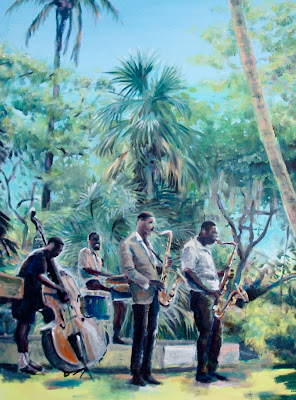 |
| Mos Def 12" x 8" oil on wood, 2010 |
However insignificant the question I posted two weeks ago may seem, for me its ramifications are very significant. The question isn't answered yet so I'm stating it again: Yes or no? And while I await the answer, that I know will appear to me (probably from an unexpected vantage point) I will post a few images from the Top 100 2009, the year before I started blogging. The images of that year's top 100 have been published in Berry van Boekel: Top 100 2009 in an edition of 100 by Iconoclast out of Cincinnati.
Number 29 in the Top 100 2009 was an anonymous B-Boy street performance made in Brooklyn. The recording appeared in the documentary film The Freshest Kids: The History of the B-Boy. The "B" in B-Boy stands for beat. The film chronicles the history of break dancing and while the dancers are mostly credited, the musicians remain largely anonymous. Luminaries from the early hip-hop scene are interviewed and I suspect that some had a hand in the soundtrack. Mod Def is one of those interviewed and since he was only a point short of being in the list himself, I chose him to illustrate the anonymous performance. This was particularly challenging simply because one of my favorite musician's portrait is of Mos Def done by Illinois based artist John Jennings.
 |
| John Jennings Mos Def digital print |
The process of how the poster is produced is interesting: First there is a small pencil drawing in a sketchbook. Next there is a scan of it. The coloring, the effects, and all the rest of the work is done on a computer. I used the concept once in an advanced drawing class for college students. The students could use any drawing they fancied and take it from there. I was surprised how little experience students from this computer savvy generation had with graphic programs. It took a while to get it going. The process sounds easy but in reality it is not so. What it really requires is vision, you have to be able to make a mental image of the sketch as a finished product. John Jennings came for a visit, the students met him, saw his work...and his visions. A few students were inspired. And that's enough.






